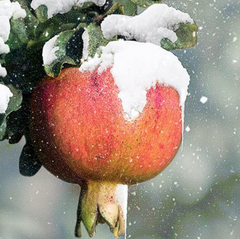As temperatures drop below zero across the country, you might be wondering: How is it possible for my fruit trees to survive, much less thrive? Well, thankfully…there’s a solution. Whether you have a typically tropical Olive Tree on the porch or Meyer Lemon next to your garden, it’s easy to bring your edible plants indoors during chilly weather.
We make container gardening and versatility easy, so there’s no extra work required. Just follow our tips and tricks to keep your fruit trees safe when the chill of wintry months rolls in.
Olive Tree to Avocado and Beyond: Move Fruit Indoors
Don’t Strain the Tree

The most important rule? Don’t strain the tree. If your tree is too heavy to move, place it on a tray with wheels for effortless movement.
And if you have time, gradually increase the time your plant spends indoors. Many fruit trees, like citrus, need to built tolerance.
Get your fruit tree acclimated to the indoors over a period of one or two weeks, slowly increasing the time your tree spends in direct sunlight, in front of a window, in the bathroom (if it’s a tropical moisture tree), and so on.
A Change in Care
When you grow your fruit trees outdoors, you often need to water them more. But when you move them inside, your watering schedule will change.
For example, your indoor fruit tree may receive more moisture simply because it’s near a kitchen or bathroom. If it does receive more moisture, it will not need to be watered as often.
Our rule of (green) thumb: Check the soil. If the soil is dried out when you stick your finger approximately 2 or 3 inches down, your fruit tree needs to be watered. But do let trees dry out between waterings.
Indoor fruit trees also typically need at least six hours of sunlight a day. You can use a grow light can as a substitute, or simply place them in an area where they will receive as much light as possible…and a South-facing window should do just fine.
Final Checklist
Through all of the changes, it’s important to keep a few things in mind. For starters, leaf drop and fruit drop are normal, so if they happen: Don’t panic. These “drops” are a sign that your Olive Tree, Avocado Tree or whatever other edible plant you may own is adjusting to its new environment. If all the leaves end up dying but not all falling, simply pick them off the branches. You should see new leaves in about six weeks.

Furthermore, you should thin your crop and provide bug defense before the indoor move. If you remove any smaller fruit your tree is growing, it will focus on adjusting to your home.
You’ll eventually get bigger and better fruit as a result.
Last step: Before bringing your fruit trees inside, spray them with an all-natural, organic pesticide to keep any remaining (or future) bugs away.
Continuing Growth Outdoors

Ok, so you don’t want to move your fruit trees or have ground planted them. Here’s the good news: Depending on the tree and the level of winter care provided, they should be just fine.
I mean, theCold Hardy Avocado, Chicago Hardy Fig and Cold Hardy Russian Red are all hardy, down to 20 degrees, -10 degrees and 0 degrees, respectively. It’s in the name, after all! Plus, the Arbequina Olive Tree is also actually hardy down to 20 degrees as well.
And there are things you can do to help. Tree wraps provide insulation for trees and keep them warmer as temperatures drop. So, if you know that a hard freeze is coming, be sure to take a sheet and cover trees and shrubs at night.
But generally, the ground is a lot colder than the air, so it’s important to be aware of freezing roots. To prevent this, keep your plant’s roots insulated by spreading a layer of hay or pine straw around their bases.
Basically, whether you move indoors or keep outdoors with a few extra tips, fruit trees are dynamic, versatile and totally adaptable. Follow our lead with these simple instructions, and you’ll be well on your way to season-to-season thriving. See more of our favorite year-round picks here!


